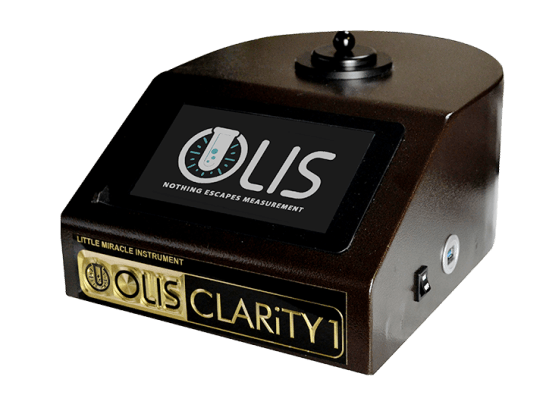Everything about Olis Clarity
Wiki Article
Little Known Facts About Olis Clarity.
Whichever wavelength selector is utilized in the spectrophotometer, the light then travels through an example. For all evaluations, determining a referral sample, typically described as the "empty sample", such as a cuvette loaded with a similar solvent utilized to prepare the example, is crucial. If a liquid buffered solution including the sample is used for dimensions, after that the aqueous buffered solution without the material of passion is used as the referral.

The reference example signal is after that later on utilized automatically by the tool to aid acquire the true absorbance values of the analytes (https://pubhtml5.com/homepage/zvhtw/). It is essential to be knowledgeable about the materials and problems utilized in UVVis spectroscopy experiments - UV/Vis/NIR. For instance, the majority of plastic cuvettes are improper for UV absorption research studies since plastic usually soaks up UV light.
Quartz sample owners are required for UV assessment since quartz is clear to the bulk of UV light. Air might likewise be considered a filter due to the fact that wavelengths of light much shorter than about 200 nm are absorbed by molecular oxygen in the air. A special and extra costly setup is needed for measurements with wavelengths much shorter than 200 nm, normally involving an optical system loaded with pure argon gas.
Olis Clarity Fundamentals Explained
After the light has passed through the example, a detector is used to convert the light right into a legible digital signal. Normally, detectors are based upon photoelectric coatings or semiconductors. A photoelectric covering expels negatively charged electrons when subjected to light. When electrons are expelled, an electric current symmetrical to the light strength is generated.
The fraction I divided by Io is also called transmittance (T), which shares how much light has gone through a sample. Nonetheless, Beer, Lambert's law is commonly put on get the concentration of the sample (c) after determining the absorbance (A) when the molar absorptivity () and the course length (L) are known.
The term optical density (OD) is often inaccurately made use of mutually with absorbance. OD and absorbance both gauge the amount of light strength lost in an optical part, however OD takes into consideration loss from light scattering whereas absorbance does not. If very little light spreading is existing in a measurement, then OD might be estimated straight using absorbance and Beer, Lambert's legislation may be made use of.
See This Report about Olis Clarity
Cuvettes designed for a 1 centimeters course length are typical and are most common. Often, really little example is readily see it here available for exam and shorter course sizes as small as 1 mm are essential. https://www.gaiaonline.com/profiles/olisclarity1/46486533/. Where quantitation is called for, absorbance worths should be kept listed below 1, within the dynamic series of the instrument
With such little light reaching the detector, some UVVis spectrophotometers are not sensitive enough to measure percentages of light accurately. 2 straightforward possible remedies to this problem are to either weaken the sample or lower the path size. As discussed above, recording a standard range making use of a "blank" reference option is necessary.
In an actual circumstance, nonetheless, the standard range will generally have some extremely small positive and adverse absorbance worths. For ideal method, these tiny absorbance worths are frequently instantly deducted from the sample absorbance worths for each and every wavelength of light by the software application to acquire the true absorbance values. 1Depending on the function of the evaluation, the building and construction of a calibration contour might be preferable.
The Ultimate Guide To Olis Clarity

Level of sensitivity is the ability to differentiate in between the small distinctions in the sample focus. Knowing the values beforehand, if offered, can assist to figure out the concentrations of the samples required, particularly where samples are limited or expensive.
When repeating the exam of an example, generally, a minimum of 3 replicate trials is typical, however many more reproduces are required in certain fields of job (https://www.directorytogoto.com/articles/unlocking-precision-the-evolution-of-spectrophotometers-by-olis-clarity). A calculated amount, such as the focus of an unidentified sample, is usually reported as an ordinary with a standard discrepancy. Reproducible results are essential to make sure precise, excellent quality dimensions
A low discrepancy or variant suggests a greater degree of accuracy and integrity. No single technique is best and UVVis spectroscopy is no exception. The strategy does, however, have a couple of primary strengths provided below that make it prominent. The method is nondestructive, allowing the sample to be recycled or proceed to more processing or evaluations.
The Only Guide for Olis Clarity
1 Light scattering - Light spreading is usually brought on by suspended solids in fluid examples, which may create serious dimension errors. The visibility of bubbles in the cuvette or sample will certainly spread light, resulting in irreproducible results. Interference from multiple taking in varieties - A sample may, as an example, have multiple kinds of the eco-friendly pigment chlorophyll.
For an appropriate quantitative analysis, each chemical species need to be separated from the example and examined independently. Geometric factors to consider - Misaligned positioning of any type of one of the instrument's components, specifically the cuvette holding the sample, may produce irreproducible and inaccurate results. It is essential that every part in the instrument is aligned in the same orientation and is placed in the very same position for every measurement.
UVVis has actually located itself applied to numerous uses and scenarios consisting of yet not restricted to: Quickly confirming the pureness and concentration of RNA and DNA is one especially widespread application. UV/Vis/NIR. A recap of the wavelengths used in their analysis and what they indicate are given up Table 1. When preparing DNA or RNA samples, for instance for downstream applications such as sequencing, it is typically important to validate that there is no contamination of one with the other, or with healthy protein or chemicals lugged over from the seclusion process
Report this wiki page